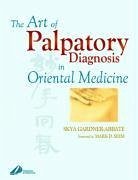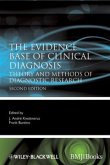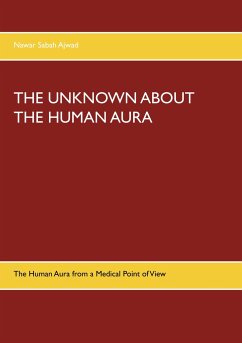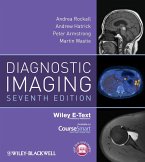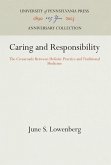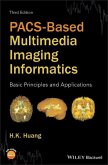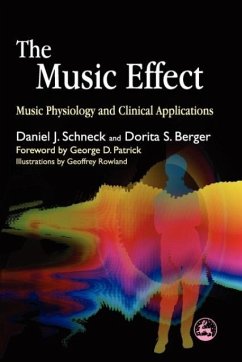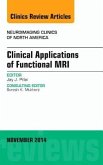Skya Gardner-Abbate
The Art of Palpatory Diagnosis in Oriental Medicine
Skya Gardner-Abbate
The Art of Palpatory Diagnosis in Oriental Medicine
- Gebundenes Buch
- Merkliste
- Auf die Merkliste
- Bewerten Bewerten
- Teilen
- Produkt teilen
- Produkterinnerung
- Produkterinnerung
Providing a step-by-step introduction and practical guide to palpation as a method of assessment, diagnosis, and treatment within the context of Oriental medicine, this book emphasizes the integration of Chinese and Japanese medical thought. The book's aim to allow the reader to acquire a feel for what lies below acupuncture meridians and points and assess and treat a variety of clinical conditions.
Andere Kunden interessierten sich auch für
![The Evidence Base of Clinical Diagnosis The Evidence Base of Clinical Diagnosis]() The Evidence Base of Clinical Diagnosis127,99 €
The Evidence Base of Clinical Diagnosis127,99 €![The Unknown about the Human Aura The Unknown about the Human Aura]() Nawar Sabah AjwadThe Unknown about the Human Aura12,99 €
Nawar Sabah AjwadThe Unknown about the Human Aura12,99 €![Diagnostic Imaging Diagnostic Imaging]() Andrea G. RockallDiagnostic Imaging93,99 €
Andrea G. RockallDiagnostic Imaging93,99 €![Caring and Responsibility Caring and Responsibility]() June S. LowenbergCaring and Responsibility85,99 €
June S. LowenbergCaring and Responsibility85,99 €![Pacs-Based Multimedia Imaging Informatics Pacs-Based Multimedia Imaging Informatics]() H. K. HuangPacs-Based Multimedia Imaging Informatics225,99 €
H. K. HuangPacs-Based Multimedia Imaging Informatics225,99 €![The Music Effect The Music Effect]() Daniel J. SchneckThe Music Effect38,99 €
Daniel J. SchneckThe Music Effect38,99 €![Clinical Applications of Functional Mri, an Issue of Neuroimaging Clinics Clinical Applications of Functional Mri, an Issue of Neuroimaging Clinics]() Jay J. PillaiClinical Applications of Functional Mri, an Issue of Neuroimaging Clinics114,99 €
Jay J. PillaiClinical Applications of Functional Mri, an Issue of Neuroimaging Clinics114,99 €-
-
-
Providing a step-by-step introduction and practical guide to palpation as a method of assessment, diagnosis, and treatment within the context of Oriental medicine, this book emphasizes the integration of Chinese and Japanese medical thought. The book's aim to allow the reader to acquire a feel for what lies below acupuncture meridians and points and assess and treat a variety of clinical conditions.
Hinweis: Dieser Artikel kann nur an eine deutsche Lieferadresse ausgeliefert werden.
Hinweis: Dieser Artikel kann nur an eine deutsche Lieferadresse ausgeliefert werden.
Produktdetails
- Produktdetails
- Verlag: Elsevier Health Sciences
- Seitenzahl: 364
- Erscheinungstermin: 20. April 2001
- Englisch
- Abmessung: 255mm x 197mm x 22mm
- Gewicht: 979g
- ISBN-13: 9780443070587
- ISBN-10: 044307058X
- Artikelnr.: 22355325
- Herstellerkennzeichnung
- Libri GmbH
- Europaallee 1
- 36244 Bad Hersfeld
- gpsr@libri.de
- Verlag: Elsevier Health Sciences
- Seitenzahl: 364
- Erscheinungstermin: 20. April 2001
- Englisch
- Abmessung: 255mm x 197mm x 22mm
- Gewicht: 979g
- ISBN-13: 9780443070587
- ISBN-10: 044307058X
- Artikelnr.: 22355325
- Herstellerkennzeichnung
- Libri GmbH
- Europaallee 1
- 36244 Bad Hersfeld
- gpsr@libri.de
PART 1: Why Palpation and How to Perform it
1.Touch as Therapy. Notes and Touch 2. Traditional Chinese Medicine and
Japanese Acupuncture: Similarities and Differences. How to use the Tiger
Thermic and the Lion Thermic Warmers .3. Why Abdominal Diagnosis? 4.
Abdominal Maps in History: Classical and Modified 5. Theoretical
Clarifications. How to find your DominantEye 6. General Palpation Skills 7.
Physical Examination I: The Healthy Hara Components, Charactersitcies and
Clinical Significance. Mental Degeneration Stages of Progression 8. Part 1:
The Relationship Between the Etiological Causes of Disease and the
Pathophysiology of Tension. Part 2: The Pathophysiology of Tension in
Vulnerable areas Stomach, Navel, Scars, Thighs, Sinuses, Neck and Back.
Learn the Patterns of Stress. Protect Your Heart. 9. Physical Examination
II: Part 1: The Palpation Schema. Part 2: the Clinical Energetics of the
Clearance Points, Palpation Method and Differential Diagnosis. Four Ways to
Eliminate Blood Stasis 10. A Brief Guide to the Use of the Navel
Microsystem for Diagnosis and Root Treatment According to Classical Chin
and Japanese Traditions. 11. A Treatment Outline to the Japanese Physical
Exam. 12. Overview of the Integrative Process How to Put it Together. 13.
Theoretical Clarifications The Eight Curious Vessels. 14. The Concept of
Diagnosis and the Needle Schema. 15. The Law of Cure and the Concept of the
Healing Crisis
PART 2: Treatment of Disease
16.The Tonsillar Treatment. 17. The Major Complaint. 18. Japanese Physical
Exam: The Significance and Treatment of Scar Tissue. 19. Japanese Physical
Exam: The Treatment ofInner Thigh Compression. 20. Japanese Physical Exam:
The Treatment of the Sinuses. 21. Japanese Physical exam: The Treatment of
Neck Tension. Headache Management Plan. A Word about the Thyroid Gland.
Recommendations to Prevent Adrenal Exhaustion. 22. Japanese Physical Exam:
The Differential Diagnosis of Back Pain. 23. Acute Abdominal Syndromes. 24.
The Differential Diagnosis of Pain in Classical Chinese Medicine: Unique
Treatment Approaches and Acupoint Energetics. 25. The Modalities
PART 3: Forms
Abdominal Diagnosis: The Healthy Hara Examination. Hara Diagnosis: Modified
Abdominal Map. Navel Diagnosis Form. The Japanese Physical Exam. Scar
Treatment Form. Sinus Evaluation Form. Neck Evaluation Form. How to Perform
Back Evaluations and Treat
PART 4: Integrated Japanese Point Location, Energetics, and Needle Point
Index
Treatment of Disease Points
PART 5: Appendices
Alphabetical Index of Point Energetics of Important Points in the Japanese
Acupuncture System by Disease. Cross-reference by Meridian of Important
Point Energetics in the Japanese Acupuncture System. Subject Index.
Treatment of Disease Index. Glossary. Answers. Bibliography. Biographical
Note
1.Touch as Therapy. Notes and Touch 2. Traditional Chinese Medicine and
Japanese Acupuncture: Similarities and Differences. How to use the Tiger
Thermic and the Lion Thermic Warmers .3. Why Abdominal Diagnosis? 4.
Abdominal Maps in History: Classical and Modified 5. Theoretical
Clarifications. How to find your DominantEye 6. General Palpation Skills 7.
Physical Examination I: The Healthy Hara Components, Charactersitcies and
Clinical Significance. Mental Degeneration Stages of Progression 8. Part 1:
The Relationship Between the Etiological Causes of Disease and the
Pathophysiology of Tension. Part 2: The Pathophysiology of Tension in
Vulnerable areas Stomach, Navel, Scars, Thighs, Sinuses, Neck and Back.
Learn the Patterns of Stress. Protect Your Heart. 9. Physical Examination
II: Part 1: The Palpation Schema. Part 2: the Clinical Energetics of the
Clearance Points, Palpation Method and Differential Diagnosis. Four Ways to
Eliminate Blood Stasis 10. A Brief Guide to the Use of the Navel
Microsystem for Diagnosis and Root Treatment According to Classical Chin
and Japanese Traditions. 11. A Treatment Outline to the Japanese Physical
Exam. 12. Overview of the Integrative Process How to Put it Together. 13.
Theoretical Clarifications The Eight Curious Vessels. 14. The Concept of
Diagnosis and the Needle Schema. 15. The Law of Cure and the Concept of the
Healing Crisis
PART 2: Treatment of Disease
16.The Tonsillar Treatment. 17. The Major Complaint. 18. Japanese Physical
Exam: The Significance and Treatment of Scar Tissue. 19. Japanese Physical
Exam: The Treatment ofInner Thigh Compression. 20. Japanese Physical Exam:
The Treatment of the Sinuses. 21. Japanese Physical exam: The Treatment of
Neck Tension. Headache Management Plan. A Word about the Thyroid Gland.
Recommendations to Prevent Adrenal Exhaustion. 22. Japanese Physical Exam:
The Differential Diagnosis of Back Pain. 23. Acute Abdominal Syndromes. 24.
The Differential Diagnosis of Pain in Classical Chinese Medicine: Unique
Treatment Approaches and Acupoint Energetics. 25. The Modalities
PART 3: Forms
Abdominal Diagnosis: The Healthy Hara Examination. Hara Diagnosis: Modified
Abdominal Map. Navel Diagnosis Form. The Japanese Physical Exam. Scar
Treatment Form. Sinus Evaluation Form. Neck Evaluation Form. How to Perform
Back Evaluations and Treat
PART 4: Integrated Japanese Point Location, Energetics, and Needle Point
Index
Treatment of Disease Points
PART 5: Appendices
Alphabetical Index of Point Energetics of Important Points in the Japanese
Acupuncture System by Disease. Cross-reference by Meridian of Important
Point Energetics in the Japanese Acupuncture System. Subject Index.
Treatment of Disease Index. Glossary. Answers. Bibliography. Biographical
Note
PART 1: Why Palpation and How to Perform it
1.Touch as Therapy. Notes and Touch 2. Traditional Chinese Medicine and
Japanese Acupuncture: Similarities and Differences. How to use the Tiger
Thermic and the Lion Thermic Warmers .3. Why Abdominal Diagnosis? 4.
Abdominal Maps in History: Classical and Modified 5. Theoretical
Clarifications. How to find your DominantEye 6. General Palpation Skills 7.
Physical Examination I: The Healthy Hara Components, Charactersitcies and
Clinical Significance. Mental Degeneration Stages of Progression 8. Part 1:
The Relationship Between the Etiological Causes of Disease and the
Pathophysiology of Tension. Part 2: The Pathophysiology of Tension in
Vulnerable areas Stomach, Navel, Scars, Thighs, Sinuses, Neck and Back.
Learn the Patterns of Stress. Protect Your Heart. 9. Physical Examination
II: Part 1: The Palpation Schema. Part 2: the Clinical Energetics of the
Clearance Points, Palpation Method and Differential Diagnosis. Four Ways to
Eliminate Blood Stasis 10. A Brief Guide to the Use of the Navel
Microsystem for Diagnosis and Root Treatment According to Classical Chin
and Japanese Traditions. 11. A Treatment Outline to the Japanese Physical
Exam. 12. Overview of the Integrative Process How to Put it Together. 13.
Theoretical Clarifications The Eight Curious Vessels. 14. The Concept of
Diagnosis and the Needle Schema. 15. The Law of Cure and the Concept of the
Healing Crisis
PART 2: Treatment of Disease
16.The Tonsillar Treatment. 17. The Major Complaint. 18. Japanese Physical
Exam: The Significance and Treatment of Scar Tissue. 19. Japanese Physical
Exam: The Treatment ofInner Thigh Compression. 20. Japanese Physical Exam:
The Treatment of the Sinuses. 21. Japanese Physical exam: The Treatment of
Neck Tension. Headache Management Plan. A Word about the Thyroid Gland.
Recommendations to Prevent Adrenal Exhaustion. 22. Japanese Physical Exam:
The Differential Diagnosis of Back Pain. 23. Acute Abdominal Syndromes. 24.
The Differential Diagnosis of Pain in Classical Chinese Medicine: Unique
Treatment Approaches and Acupoint Energetics. 25. The Modalities
PART 3: Forms
Abdominal Diagnosis: The Healthy Hara Examination. Hara Diagnosis: Modified
Abdominal Map. Navel Diagnosis Form. The Japanese Physical Exam. Scar
Treatment Form. Sinus Evaluation Form. Neck Evaluation Form. How to Perform
Back Evaluations and Treat
PART 4: Integrated Japanese Point Location, Energetics, and Needle Point
Index
Treatment of Disease Points
PART 5: Appendices
Alphabetical Index of Point Energetics of Important Points in the Japanese
Acupuncture System by Disease. Cross-reference by Meridian of Important
Point Energetics in the Japanese Acupuncture System. Subject Index.
Treatment of Disease Index. Glossary. Answers. Bibliography. Biographical
Note
1.Touch as Therapy. Notes and Touch 2. Traditional Chinese Medicine and
Japanese Acupuncture: Similarities and Differences. How to use the Tiger
Thermic and the Lion Thermic Warmers .3. Why Abdominal Diagnosis? 4.
Abdominal Maps in History: Classical and Modified 5. Theoretical
Clarifications. How to find your DominantEye 6. General Palpation Skills 7.
Physical Examination I: The Healthy Hara Components, Charactersitcies and
Clinical Significance. Mental Degeneration Stages of Progression 8. Part 1:
The Relationship Between the Etiological Causes of Disease and the
Pathophysiology of Tension. Part 2: The Pathophysiology of Tension in
Vulnerable areas Stomach, Navel, Scars, Thighs, Sinuses, Neck and Back.
Learn the Patterns of Stress. Protect Your Heart. 9. Physical Examination
II: Part 1: The Palpation Schema. Part 2: the Clinical Energetics of the
Clearance Points, Palpation Method and Differential Diagnosis. Four Ways to
Eliminate Blood Stasis 10. A Brief Guide to the Use of the Navel
Microsystem for Diagnosis and Root Treatment According to Classical Chin
and Japanese Traditions. 11. A Treatment Outline to the Japanese Physical
Exam. 12. Overview of the Integrative Process How to Put it Together. 13.
Theoretical Clarifications The Eight Curious Vessels. 14. The Concept of
Diagnosis and the Needle Schema. 15. The Law of Cure and the Concept of the
Healing Crisis
PART 2: Treatment of Disease
16.The Tonsillar Treatment. 17. The Major Complaint. 18. Japanese Physical
Exam: The Significance and Treatment of Scar Tissue. 19. Japanese Physical
Exam: The Treatment ofInner Thigh Compression. 20. Japanese Physical Exam:
The Treatment of the Sinuses. 21. Japanese Physical exam: The Treatment of
Neck Tension. Headache Management Plan. A Word about the Thyroid Gland.
Recommendations to Prevent Adrenal Exhaustion. 22. Japanese Physical Exam:
The Differential Diagnosis of Back Pain. 23. Acute Abdominal Syndromes. 24.
The Differential Diagnosis of Pain in Classical Chinese Medicine: Unique
Treatment Approaches and Acupoint Energetics. 25. The Modalities
PART 3: Forms
Abdominal Diagnosis: The Healthy Hara Examination. Hara Diagnosis: Modified
Abdominal Map. Navel Diagnosis Form. The Japanese Physical Exam. Scar
Treatment Form. Sinus Evaluation Form. Neck Evaluation Form. How to Perform
Back Evaluations and Treat
PART 4: Integrated Japanese Point Location, Energetics, and Needle Point
Index
Treatment of Disease Points
PART 5: Appendices
Alphabetical Index of Point Energetics of Important Points in the Japanese
Acupuncture System by Disease. Cross-reference by Meridian of Important
Point Energetics in the Japanese Acupuncture System. Subject Index.
Treatment of Disease Index. Glossary. Answers. Bibliography. Biographical
Note

